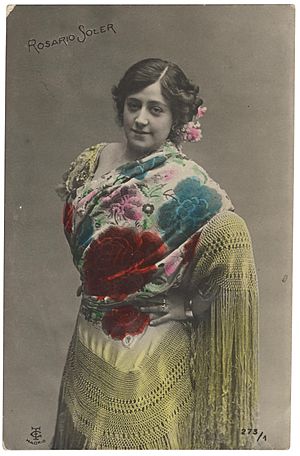Rosario Soler facts for kids
Rosario Soler (nicknamed "La Patita") was a talented Spanish actress and singer. She was born in Málaga, Spain, on August 16, 1879, and passed away in the same city on November 22, 1944. She became famous for her lively performances on stage.
Contents
Early Life and Career
Rosario Soler was born Rosario Illescas Sánchez in the Victoria neighborhood of Málaga. She started her acting career at a young age at the Teatro Vital Aza in Málaga. When she was 16, she moved to Madrid to perform in smaller theaters. Her official debut in Madrid was at the Príncipe Alfonso theater in 1896.
Becoming "La Patita"
In the same year, Rosario traveled to Mexico. She became a big hit at the Teatro Principal with her performance in a show called La marcha de Cádiz. It was during this time that she earned her famous nickname, "La Patita." This nickname came from a song she sang in the show. People described her as "simpatica" (which means friendly and pleasant in Spanish) and "magnetic" because of her charming personality.
International Success
After her success in Mexico, Rosario Soler traveled to Havana, Cuba, performing at the Payret Teatro in 1901. She then went to Milan, Italy, to study singing and improve her voice.
Return to Spain
Rosario returned to Spain in 1903 and continued her stage career. She performed in many famous theaters like Tivoli, el Eslava, Novedades, Vital Aza, and Teatro de la Zarzuela. Some of her most notable performances were in shows like Mozo Crúo and La Revoltosa. In 1907, she performed in the zarzuela (a Spanish musical play) called "Las Bribonas" at the Apollo theater.
Famous Roles
Rosario Soler was especially known for her role in Los Cocineros (The Cooks). She sang a popular waltz-song in this show, accompanied by a chorus dressed as cooks who beat time on skillets. This performance was very popular throughout Mexico City. She was also praised for her role in “La Viejecita” (The Little Old Lady). In this play, she brilliantly acted as a young officer who pretends to be a little old lady to get into a ball. Her acting was described as intense, energetic, and delicate.
Later Years
After spending ten years performing in Mexico, New York City, and Havana, Rosario Soler returned to Madrid in 1923. She gave an amazing performance in the operetta El niño judío (The Jewish Boy) at the Price theater. She later retired from acting in Nice, France. In 1931, she moved back to her hometown of Málaga, where she passed away on November 22, 1944.
See also
- In Spanish: Rosario Soler para niños


